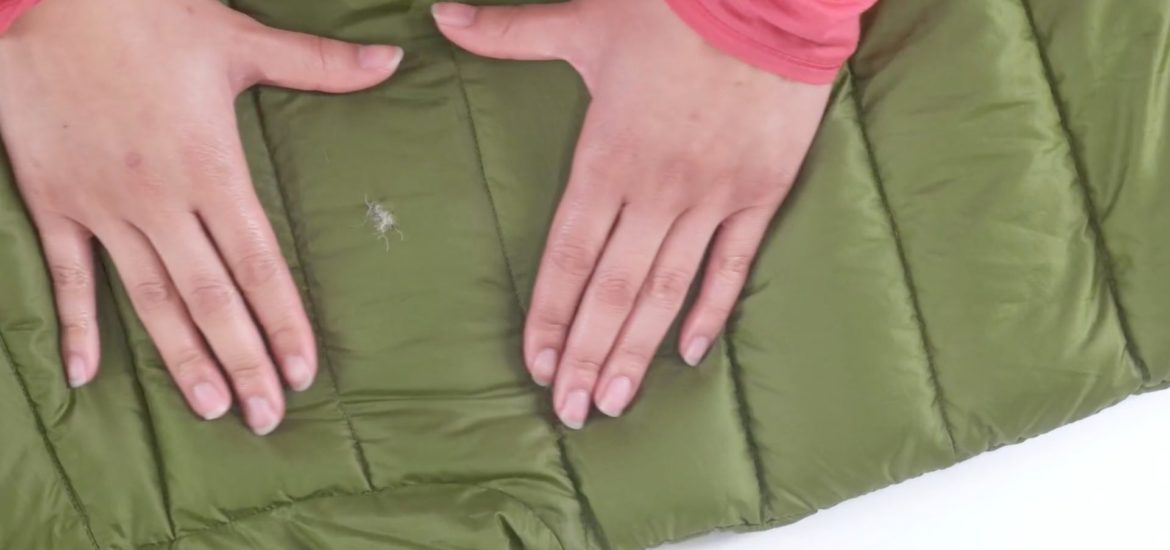Knowing whether your sleeping bag can catch fire is important for your safety while camping. Fire outbreaks remain a major risk while outdoors, and the best way to minimize it is by choosing fire-retardant gear.
So, let’s explore how flammable sleeping bags are and what makes them fire-retardant.
Article Contents:
What are Sleeping Bags Made From?

A sleeping bag is made from three distinct layers: an outer layer, inner layer, and fill material.
The outer layer or shell of the sleeping bag is made from nylon, polyester, taffeta, ripstop nylon/polyester, or DryLoft material. Most sleeping bags are coated with a layer of DWR (Durable Water Repellent) to repel moisture and combat condensation.
The interior layer or the lining comes in materials such as nylon, synthetic, cotton, or poly-cotton.
The fill materials, which is responsible for providing insulation is typically made from natural (down, cotton, or wool) or synthetic (poly fibre) fibres.
It is the weave and weight of the outer layer that plays a key role in your sleeping bag flammability. Moreover, constant exposure to heat and flames can make any material catch fire – hence not ‘fireproof’ [Reference].
Sleeping bags labeled “fire-retardant” don’t necessarily mean “fireproof”. Most of them have chemicals applied over them to resist fire. But, you will also find sleeping bag fire-resistant options without chemicals as they are considered safer for use.
Are Down-Filled Sleeping Bags Flammable?
Down-filled sleeping bags are not considered flammable. Down is actually considered on of the least flammable bedding materials and will show a significant resistance to fire [Reference].
However, as mentioned previously, it is the outer material that will dictate the sleeping bag flammability. Tightly woven synthetic fibres don’t ignite easily. Instead they melt and create a burn hole when caught on fire.
Are Synthetic-Filled Sleeping Bags Flammable?
Synthetic-filled sleeping bags have a low flammability rating. Synthetic fill like poly-fiber needs more heat to ignite. When on fire these materials can melt unless they are specially treated to resist fire.
Again, the shell material is a decisive factor of sleeping bag flammability.
North American Sleeping Bag Flammability Guidelines

Both the U.SA and Canada have similar guidelines regarding sleeping bag flammability. While some regions don’t mandate it as legislation, the flammability comes under the general safety requirements of camping.
Manufacturers are advised to comply with these guidelines in order to ensure their product is safe for users.
Why are Sleeping Bags Tested for Flammability?
Sleeping bags come in a variety of materials and it can impact their level of flammability. They can accelerate the fire and even remain as an obstacle to escape during fire outbreaks. This is why it’s important to purchase one that has passed the sleeping bag flammability test.
Testing conditions state that a sleeping bag should not exceed a burn rate of 15 centimetres per minute.
How are Sleeping Bags Tested?
In Canada, the Standard Test Method for Flammability of Sleeping Bags (ASTM F1955-20) tests the burn rate of sleeping bag materials. The American equivalent is the Rate of Burn Standard for Sleeping Bags (CPAI-75:1976A).
A sample of the sleeping bag material is set on fire under specified conditions. The burn rate is denoted in centimeters per minute, and the products that comply with the burn rate requirements will be labeled as such to help buyers identify them.
Both the fabric and coatings of sleeping bags play a role in their fire-retardant ability. For this reason, burn rates are tested both before and after sleeping bags are laundered according to the manufacturer’s instructions.
- Washing or dry-cleaning sleeping bags multiple times may increase their flammability as the protective coating can wear out
They are even tested following tight storage conditions which might impact the rate of fire spreading.
How Far Away Should You Sleep From a Fire?

Although it might be tempting to pitch your tent or move your sleeping bag closer to the fire during cooler nights, it’s not a good idea. The hot embers and sparks from a camp fire can easily land in your direction. Fire size, type of wood, and wind conditions can also exacerbate the risk.
In general, you should never leave a fire unattended. Even a semi-extinguished fire can pose a considerable hazard.
- Maintain a minimum distance of 3 meters (10 feet) between the campfire and your sleeping bag
- If it’s a large fire and the weather conditions are unfavourable, maintain at least 6 meters (20 feet) away
How to Repair a Sleeping Bag Burn Hole

If an ember lands on your sleeping bag and leaves a sizable hole it can cause the insulating material to come out over time.
So, here’s a first-aid measure to prevent further damage and how to repair your sleeping bag. I recommend using Tenacious Tape Repair Patches. The repair process is fairly easy and straightforward.
Here’s how to repair a small hole in a sleeping bag:
- Locate the hole and prepare it by trimming the edge of any loose fibre filaments if necessary
- If there’s any debris or moisture near the hole, clean it with water and a cloth then let it dry
- Insert any fill materials that has come out of the hole
- Place the tenacious repair tape over the hole, and smooth the edges to eliminate any air bubbles and creases
This article contains affiliate links, which help support this blog at no cost to you!
